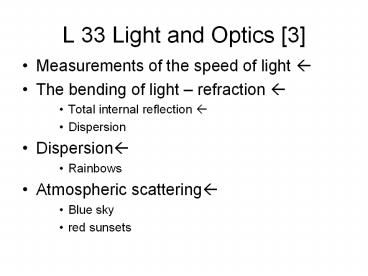L 33 Light and Optics [3] PowerPoint PPT Presentation
1 / 19
Title: L 33 Light and Optics [3]
1
L 33 Light and Optics 3
- Measurements of the speed of light ?
- The bending of light refraction ?
- Total internal reflection ?
- Dispersion
- Dispersion?
- Rainbows
- Atmospheric scattering?
- Blue sky
- red sunsets
2
Light and optics
- images formed by mirrors
- plane mirrors
- curved mirrors
- concave
- convex
- Images formed by lenses
- the human eye
- correcting vision problems
- nearsightedness
- farsightedness
- astigmatism
- depth perception
3
light and optics
- effects related to the wave nature of light
- polarization
- interference
- thin film interference
- diffraction
- resolving close objects
4
Image formation with lenses
- converging lens (positive lens)
- diverging lens (negative lens)
- the human eye
- correcting for nearsightedness
- correcting for farsightedness
- optical instruments
- lenses are relatively simple optical devices
- the principle behind the operation of a lens is
refraction? the bending of light as it passes
from air into glass (or plastic)
5
converging lens
focal point F
?a converging lens focuses parallel rays to a
point called the focal point. ? a thicker lens
has a shorter focal length
6
Diverging lens
F
A diverging lens causes parallel rays to
diverge as if they came from a focal point F
7
Image formation by a converging lens
image
F
2F
object
?If the object is located at a distance ofat
least 2F from the lens, the image is inverted and
smaller than the object. ?The image is called a
REAL image since light rays actually converge at
the image location
8
A converging lens is used tofocus rays from the
sun to a point
since the sun is very far from the lens, the rays
are nearly parallel
9
converging lens is used in a camera to focus
light onto the film
when you focus a camera, you adjust the distance
between the lens and the film depending on the
object location.
10
Image formation by a diverging lens
image
Object
- ?The diverging lens produces an image that is
upright - and diminished in size.
- It is a VIRTUAL image, since light rays do not
- actually pass through the image point
11
a magnifying lens
F
F
Object
virtual image
By placing the lens close to the object we get a
magnified virtual image.
12
Sight the human eye
- Physics of the human eye
- Abnormal vision
- Nearsightedness
- Farsightedness
- astigmatism
- Depth perception
13
The Eye
- light enters through the cornea
- the iris controls the amount of light that gets
in, a muscle can close it or open it, the iris is
determimes your eye color - the lens is filled with a jelly-like substance
the ciliary muscle can change the shape of the
lens and thus change its focal length
?by changing the focal length, (accommodation)
the lens is able to focus light onto the retina
for objects located at various distances
14
the physics of the human eye
The relaxed eye can easily focus on
distant objects. To focus on close objects the
lens is squeezed to shorten its focal length,
making it possible to converge the rays onto the
retina. The near point is the distance at which
the closest object can be seen clearly. It
recedes with age.
15
When a nearsighted person views a distant object,
the lens cannot relax enough to focus at the
retina. The rays converge too quickly. The remedy
is to place a diverging lens in front of the eye
to first diverge the
16
When a farsighted person tries to focus on a
close object the lens cannot be squeezed enough
to focus on the retina. The focus point is behind
the retina. The remedy is to place a converging
lens in front of the eye to converge the
rays before they enter the eye.
Weh
17
How does the eye judge distance?
- Our brain interprets the images formed on the
retinas of both eyes as a single image ? this is
called binocular vision - Our eyes roll inward slightly to focus on the
distant point D. Our brain interprets the
distance BD by the muscular effort required to
roll the eyes inward.
18
astigmatism
- Astigmatism means that the cornea is oval like a
football instead of spherical like a basketball.
Most astigmatic corneas have two curves a
steeper curve and a flatter curve. This causes
light to focus on more than one point in the eye,
resulting in blurred vision at distance or near
19
Astigmatism
Astigmatism can be corrected with
specially shaped lenses or, in extreme cases,
with surgery

